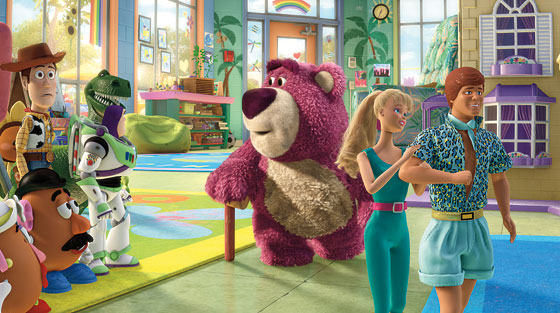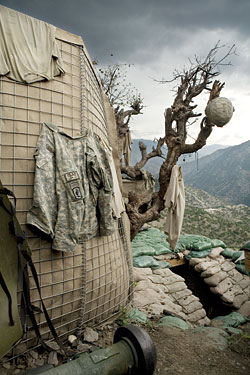
Back in the sixties and seventies, before films became “franchises” and “tent poles,” before Jaws and Star Wars and corporate-studio ownership changed everything, the “summer blockbuster” wasn’t a genre unto itself, a megabudget cartoon tooled to help us escape from our lives. It hadn’t been commoditized yet. And escapism took different forms. I spent my childhood in an upper-middle-class suburb, one of those doomed artificial constructs in which the outside world is kept vigorously at bay. Isolated from the counterculture, the war, the racial upheavals of the big cities, I went to blockbusters like In the Heat of the Night, Easy Rider, and Woody Allen’s Bananas to escape to reality. There was lots of crap, but of a different order than this season’s The A-Team and Killers and Shrek XXV and Iron Man 2—which cost hundreds of millions and are not so much made as microengineered.
I’ve never blamed Jaws for what happened: It’s the best summer movie ever made. People forget how real it seemed. It was shot in a beach resort (Martha’s Vineyard) in the days when Steven Spielberg was forced to use the world as he found it instead of building one from scratch. I loved the tension between the texture of life and his smooth, beautifully modulated, movie-ish technique. I saw it opening night in a sold-out, electrified house. The movie has what’s still my favorite scare: Roy Scheider, shot from above (with plenty of water behind him), calling out, “Why don’t you guys come down here and shovel some of this shit?” and just when we’re starting to laugh (“He said ‘shit’!”) the shark comes out of the blue, no preamble, no music, just teeth and the sound of a crowd shrieking as one.
No, the beginning of the end was Star Wars, synthetic then as now, clever but never exhilarating, infinitely merchandisable. With any luck, this summer’s most merchandisable blockbuster, Toy Story 3, will be the last of the Toy Story movies. Yes, there will be pressure on Pixar to squeeze out sequels. But the chances of topping this one are infinitesimal. It’s another paradoxical Pixar beauty: the high-tech ode to the old-fashioned, the vintage, the stuff of childhood fantasy play when kids and not computer programmers supplied the imagination.
I don’t think of the Toy Story pictures as “escapism,” even though they’re rooted in a child’s dream of what happens when the lights go out and the toys come to life. At heart they’re about aging, impermanence, loss, and death. Pixar likely borrowed the premise from Thomas M. Disch’s The Brave Little Toaster: Objects once prized lose their newness and become disposable. But they have spiritual properties, and to discard them carelessly is to dishonor the past that shaped us. It’s almost Buddhist in how it invests all matter with a life force worthy of reverence.
Toy Story 3 has another dimension, probably the upshot of creators John Lasseter, Andrew Stanton, and director Lee Unkrich’s getting older and having families. The toys—especially the cowboy Woody (with the voice of Tom Hanks)—see the boy who owns them, Andy, through the eyes of parents with kids who are ready to move on. After a wild prologue with Woody and Tim Allen’s Buzz Lightyear and Joan Cusack’s cowgirl Jessie saving a trainload of orphans from the evil pig mastermind—which comes to a halt when young Andy is called to dinner—we jump a decade ahead. Andy no longer plays with toys; he’s going off to college. His room is being cleared for his younger sister with her MP3 player and computer. Should the toys be stuck in the attic? Donated to Sunnyside, a children’s day-care center? Or left on the curb for the garbage truck? The gang, which includes the sister’s cast-off Barbie (voiced by Jodi Benson), is scared by the prospect of all those possibilities.
After mix-ups and chases, they end up at Sunnyside, where the toy who calls the shots is the formidable huggy bear, Lotso, with the great southern stentorian voice of Ned Beatty. Lotso is a character with stature—a toy shattered by abandonment who has purged himself of sentiment. And soon our gang discovers he runs Sunnyside as a kind of prison. The big bald baby doll functions as a spooky enforcer and looks like the Swedish wrestler Tor Johnson in Ed Wood movies. A cymbal-clashing monkey is the prison guard of nightmares. Horror of horrors, Buzz is reprogrammed to be his old pompous self to help Lotso keep everyone in cages. Suddenly, thrillingly, Toy Story 3 becomes a prison-break movie.
As usual with Pixar, the little things win your heart, like Woody escaping out the bathroom window but pausing to put down a sheet of toilet paper before stepping on the seat. At Sunnyside, Barbie meets Ken (Michael Keaton), and all our culture’s Ken-is-gay jokes get a new spin: He’s a metrosexual elated at finding someone to whom he can show off his disco wardrobe. The gags are all of a piece, right up to the forlorn yet enchanting finale.

Kids will love Toy Story 3 for its cliff-hangers and slapstick spills. But for grown-ups, the film will touch something deeper: the heartfelt wish that childhood memories will never fade. This lovely, wistful movie weaves together our joyful fantasies of the past, the ones that helped form us, and our darker fears of being forgotten—and offers hope that we can somehow reconcile those poles of existence for ourselves. The slight autumnal chill makes the warmth of summer all the sweeter.
The documentary Restrepo is set in an alien world and has a touch of the surreal, but it’s the furthest extreme from escapism. In 2007, directors Tim Hetherington and Sebastian Junger (the best-selling writer) got themselves embedded with Battle Company’s Second Platoon, the “tip of the spear” in the remote Korengal Valley in Eastern Afghanistan, in makeshift hillside outposts not far from the mountains of Pakistan. Hetherington and Junger shot the film themselves and kept their cameras going during the frequent firefights, although this isn’t what you’d call smooth cinematography: You can feel the fight-or-flight instincts in how their cameras swerve and point at the ground or the sky. Experiencing their terror vicariously, you might wish they were holding weapons instead of cameras.
The film is a nearly unrelenting nightmare. Even interviews shot with the survivors after the fact have a current of dread. It opens with rollicking video of the company medic, Restrepo, as he sits on a train and drunkenly shouts, “We’re goin’ to war! We’re goin’ to war!” The larger-than-life Restrepo’s large life ended with two bullets in the neck; he bled out on a helicopter. The new, scarily exposed outpost is, like the film, named in his honor. But this is a place where no foreign force will likely gain the upper hand. Although we’re told that roughly 70 percent of the ordnance in Afghanistan is deployed in the battalion’s area of operations, the landscape from a distance appears unmarked, the bombs absorbed by the same trees and terraced hills that hide the Taliban—who are never actually seen. Monkeys howl as the men gaze into those trees through gun sights, their most trivial exchanges seeming, in this context, momentous. Every other word is “fuck.” The pressure shows.
Restrepo isn’t all scenes of life on the outpost. The earnest new captain, Kearney, often trudges into the small, impoverished village below to meet with the Korengali elders. They stare at him, expressionless, their beards dyed orange, as he tells them, via a translator, that he’s different from his predecessor, that he won’t round up their families and send them to Bagram for interrogation: “Join with the government and I’ll flood this whole place with money, with projects … ” Then seven civilians are killed (and small children wounded) and whatever hearts and minds were in play (probably not many) are lost.
Restrepo is, on its own terms, a stunning piece of work, but to get even more from it you should buy Junger’s book, WAR, which expands on the footage we see, adding world history and personal history and vivid detail, including sections on the neurochemistry of soldiers under fire. I could end this review with a pronouncement about how supposed war movies like The A-Team cheapen and demean the courage of these soldiers—but I’m not sure they wouldn’t enjoy the break from reality. In one scene, we see a soldier playing a war video game and enjoying himself. It’s clearly wonderful to find a place to put all that adrenaline and to understand, for once, the rules of engagement.
See Also:
Why Sebastian Junger
Misses the War
E-mail: filmcritic@newyorkmag.com.
